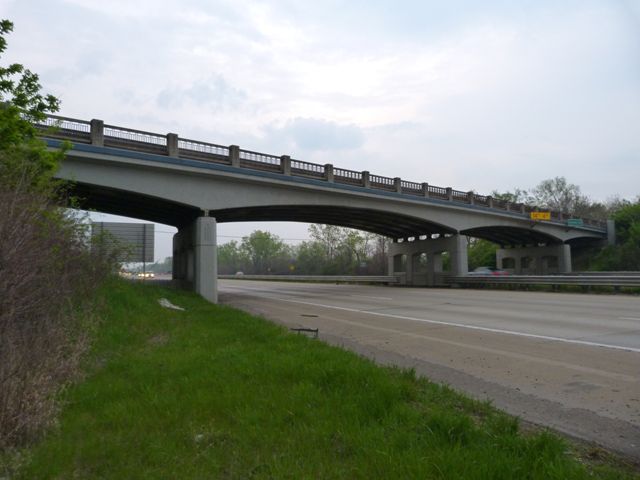We Recommend:
Bach Steel - Experts at historic truss bridge restoration.
BridgeHunter.com Phase 1 is released to the public! - Visit Now
Dunbar Road Bridge

Primary Photographer(s): Nathan Holth
Bridge Documented: May 13, 2011
Rural: Monroe County, Michigan: United States
1955 By Builder/Contractor: W. H. Knapp Company of Monroe, Michigan and Engineer/Design: Michigan State Highway Department
Not Available or Not Applicable
70.0 Feet (21.3 Meters)
236.0 Feet (71.9 Meters)
26 Feet (7.92 Meters)
4 Main Span(s)
58158151000S110

View Information About HSR Ratings
Bridge Documentation
View Archived National Bridge Inventory Report - Has Additional Details and Evaluation
This bridge is one of s small number of remaining curved t-beam overpasses on I-75 south of Detroit that retain original railings. It is one of two that was listed on the National Register of Historic Places as a result of the Michigan Historic Bridge Inventory. Today, the Dunbar Road Bridge has had Armco guardrails added to it, but otherwise retains historic integrity. It is not known why Dunbar Road was singled out as historic, since its design, size, and historic integrity is similar to other curved t-beams on this section of freeway that were not found historic. HistoricBridges.org considers all of the curved t-beams on this freeway with original railings to have historic value because they all represent the earliest use of this very attractive expressway overpass that was built on Michigan freeways from 1954 through about 1961. These t-beams are also distinguished by their unique curved abutment railings which are not seen on curved t-beam overpasses on other freeways.
Information and Findings From Michigan Historic Bridge InventoryThe four-span Dunbar Road Bridge, which is skewed, crosses lanes of I-75 and a median. Piers are concrete with three arched openings. The two-lane-wide deck is carried by six T-beams. The bridge displays standard State Highway Department railings consisting of metal panels between concrete posts. Bridge plates are affixed at the northeast and southwest corners. The structure is located just south of the Monroe city limits.Built in 1955, this structure is one of 37 bridges and grade separations constructed for the Detroit-Toledo Expressway by June 1956. The contractor for this project was W.H. Knapp Company of Monroe which submitted the low bid of $118,676.70. The new expressway was part of the state highway department’s emphasis on trunkline improvement and expressway development in the period which followed World War II. The Detroit-Toledo Expressway was not the first important north-south road to traverse the eastern section of Monroe County. The Dixie Highway became the first highway in Michigan in 1829. This dirt road was built a short distance to its west. Both roads are still in use, but have mainly carried local traffic since the opening of I-75 in 1956. It was hoped that the new expressway would relieve some of the heavy truck traffic clogging Telegraph Road. Although I-75 does not follow exactly the route of either of the earlier roads, the importance of traffic flow through the corridor is evident. Survey work for the new expressway was completed by June 1952, and bridge work on the approximately 25-mile route began during the 1953-54 biennium. The road bed and bridges and grade separations were designed to allow for the future addition of a third traffic lane in each direction. Of the interstate highways being built outside of the Detroit metropolitan area, the routes for I-75 and I-94 (Detroit to Chicago) were the furthest toward completion by the mid-1950s. The state highway department first issued standard plans for concrete T-beam bridges during the 1913-1914 biennium. The design was used sparingly until the development of the interstate highway system in the 1950s and 1960s. By that time, curved beams were being used for greater under-bridge clearance. |
![]()
Photo Galleries and Videos: Dunbar Road Bridge
Bridge Photo-Documentation
Original / Full Size PhotosA collection of overview and detail photos. This gallery offers photos in the highest available resolution and file size in a touch-friendly popup viewer.
Alternatively, Browse Without Using Viewer
![]()
Bridge Photo-Documentation
Mobile Optimized PhotosA collection of overview and detail photos. This gallery features data-friendly, fast-loading photos in a touch-friendly popup viewer.
Alternatively, Browse Without Using Viewer
![]()
Maps and Links: Dunbar Road Bridge
Coordinates (Latitude, Longitude):
Search For Additional Bridge Listings:
Bridgehunter.com: View listed bridges within 0.5 miles (0.8 kilometers) of this bridge.
Bridgehunter.com: View listed bridges within 10 miles (16 kilometers) of this bridge.
Additional Maps:
Google Streetview (If Available)
GeoHack (Additional Links and Coordinates)
Apple Maps (Via DuckDuckGo Search)
Apple Maps (Apple devices only)
Android: Open Location In Your Map or GPS App
Flickr Gallery (Find Nearby Photos)
Wikimedia Commons (Find Nearby Photos)
Directions Via Sygic For Android
Directions Via Sygic For iOS and Android Dolphin Browser
USGS National Map (United States Only)
Historical USGS Topo Maps (United States Only)
Historic Aerials (United States Only)
CalTopo Maps (United States Only)

